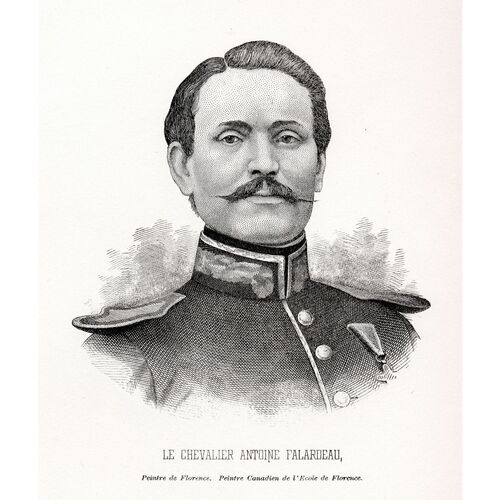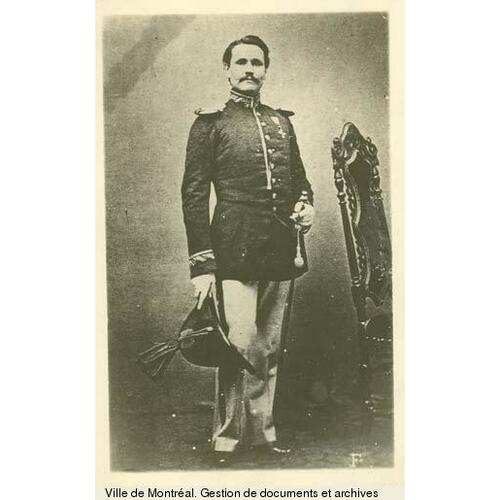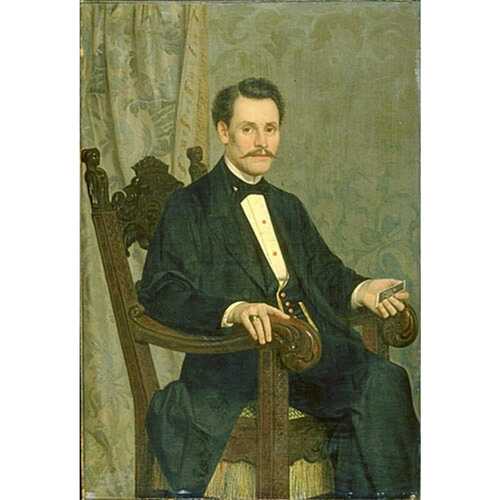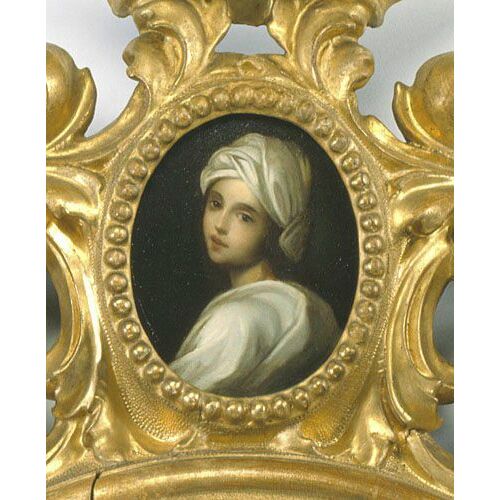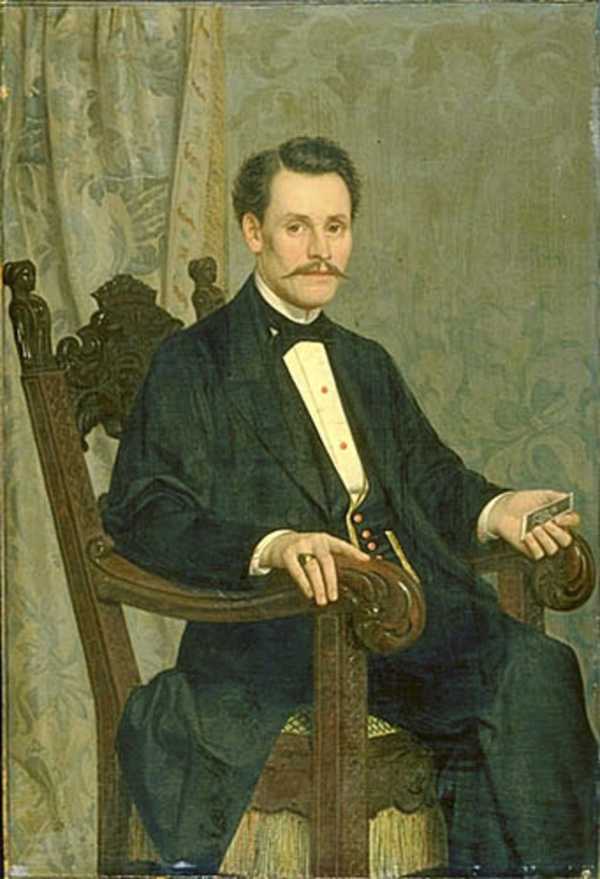
Source: Link
FALARDEAU, ANTOINE-SÉBASTIEN (baptized Antoine), painter; b. 13 Aug. 1822 at Cap-Santé, Lower Canada, son of Joseph Falardeau, a farmer, and Isabelle (Élizabeth) Savard (Savarre); m. 7 Sept. 1861 Caterina Mannucci-Benincasa in Florence, Italy; d. there 14 July 1889, drowned when his horse bolted, throwing him into the river.
Settling in Florence
Antoine-Sébastien Falardeau apparently ran away from home at about 14 years of age and went to try his luck in Quebec City. Thanks to an aunt, he found work at the house of Dr James Arthur Sewell. The nature of his artistic apprenticeship remains a mystery; it is known only that young Falardeau took courses in painting and that in 1841 he was an apprentice sign-painter with Robert Clow Todd* while also working as a clerk. The Italian painter Gerome Fassio*, who had been in Quebec City since 1835, may have turned Falardeau’s thoughts towards Italy and even taught him the rudiments of Italian. It is possible that the merchant Abraham Hamel, brother of Théophile*, supported his projects financially. But his relations with Théophile Hamel probably had little artistic significance.
On 14 Nov. 1846, with meagre resources, Antoine-Sébastien Falardeau left Quebec for Florence where he was to spend most of his life. It is thought that he studied at the academy of fine arts there, and that he won the first prize at the academy of fine arts in Parma for a copy of Correggio’s Il Giorno. After some difficult years, he gained a reputation as a skilled artist and also some degree of wealth. Appointed a knight of the order of Saint-Louis on 17 Jan. 1852 by Charles III, Duke of Parma, on 7 Sept. 1861 he married Caterina Mannucci-Benincasa, daughter of the Marquis Francesco Mannucci-Benincasa Capponi; the couple had at least three children.
Success
The comments of artist Napoléon Bourassa*, who lived near Falardeau in Florence in 1852, suggest that he was a meticulous man, dedicated to his work, enthusiastic, and resolute. “I have been surprised to see the strength of his character. . . . He is cheerful, and has the turn of mind to rouse the gravest of men to laughter. . . . He is the most scrupulously careful man imaginable.” Finally, “he is quite as inflexible as I [am] in [his ideas], and does not understand how someone can think differently from himself.” A year later, Bourassa wrote to Théophile Hamel: “Falardeau is doing well in Florence; he has set himself up this spring in accommodation which certainly suggests his taste, work, and thrift. . . . I believe that within ten years he will succeed in duplicating the contents of the galleries in Florence.” Falardeau was above all a copyist; Carlo Dolci and Guido Reni apparently were his favourites. He also did “excellent drawings from nature.” We know that he painted portraits. In 1882, for example, the Canadian government commissioned him to do a portrait of former Quebec Premier Joseph-Adolphe Chapleau* for $500. In his book on the artist, Émile Falardeau expressed the opinion that he executed more than 300 original paintings. There is, however, no evidence to support the assertion.
Falardeau’s career in Italy was followed with interest by his compatriots in Canada. He made two brief visits to Canada in 1862 and 1882, on both occasions exhibiting his work. Montreal and Quebec City newspapers pointed with pride to his success abroad and encouraged “art lovers to go and admire the works of a Canadian artist who brings such honour to Canada.” The public response was enthusiastic enough that Antoine Plamondon*, who could brook no rival, went on the attack and denounced copies made by artists in Italy.
Works
Antoine-Sébastien Falardeau’s paintings have been so widely dispersed that a study of his work is likely to remain impossible. There certainly are several works in Italy; others, bought by tourists, have gone into oblivion, a common fate for copies. It is difficult to determine the exact number of his paintings in Canada. According to newspaper articles published during his visits to Canada he brought more than 100 paintings in 1862 and sold them in Quebec City and Montreal, and in 1882 sold 75 canvases at prices ranging from $20 to $250. He also did a collection in the 1850s for Egerton Ryerson during a trip to Europe, and completed portraits and original works commissioned during his two stays and by visitors to Italy. Hence it can be asserted there were more than 200 paintings by Falardeau in Canada.
Although no assessment can be made of Falardeau’s work as a whole, his talents as a copyist must be acknowledged. Napoléon Bourassa, who visited him every day, stated that “he has few equals at Florence among those who make copying their profession.” His copies were “irreproachable,” and his drawings from nature “excellent.” Falardeau’s marvellous little picture representing Beatrice Cenci (long attributed to Guido Reni), now held by the Musée National des Beaux-Arts du Québec, gives a good idea of his talent. In the words of Henri-Raymond Casgrain*, he “has more charm than boldness, more subtlety and elegance than vigour, more exquisite delicacy and feeling than energy. He excels in perfection of finish, in poetry of execution. His miniatures have a truthfulness of tone, a purity of line, a transparency and freshness, a harmony of style and often a naïvety, that are delightful.” Several of the 20 or so pictures held at the Musée National des Beaux-Arts du Québec are of this high quality.
Private arch., Anne Bourassa (Montréal), Lettre de Napoléon Bourassa à Charles Laberge, 19 déc. 1852; Madeleine Hamel (Québec), Lettre de Napoléon Bourassa à Théophile Hamel, décembre 1853. IBC, Centre de documentation, Fonds Morisset, 2, F177/A634.7.
Le Canadien, 16 nov. 1846. Le Journal de Québec, 22 août 1862. La Minerve, 2, 17, 19, 22 juill. 1862; 10, 18 juill. 1882. Georges Bellerive, Artistes-peintres canadiens-français; les anciens (Québec, 1925). H.-R. Casgrain, A. S. Falardeau et A. E. Aubry (Montréal, 1912). Émile Falardeau, Un maître de la peinture: Antoine-Sébastien Falardeau (Montréal, 1936). A. H. Robson, Canadian landscape painters (Toronto, 1932).
Bibliography for the revised version:
Bibliothèque et Arch. Nationales du Québec, Centre d’arch. de Québec, CE301-S8, 13 août 1822. Virginia Nixon, “Antoine-Sébastien Falardeau (1822–1889) and the old master copy in the nineteenth century” (ma thesis, Concordia Univ., Montreal, 1988); “Egerton Ryerson and the old master copy as an instrument of public education,” Journal of Canadian Art Hist. (Montreal), 27 (2006): 94–113.
Cite This Article
Raymond Vézina, “FALARDEAU, ANTOINE-SÉBASTIEN,” in Dictionary of Canadian Biography, vol. 11, University of Toronto/Université Laval, 2003–, accessed January 10, 2026, https://www.biographi.ca/en/bio/falardeau_antoine_sebastien_11E.html.
The citation above shows the format for footnotes and endnotes according to the Chicago manual of style (16th edition). Information to be used in other citation formats:
| Permalink: | https://www.biographi.ca/en/bio/falardeau_antoine_sebastien_11E.html |
| Author of Article: | Raymond Vézina |
| Title of Article: | FALARDEAU, ANTOINE-SÉBASTIEN |
| Publication Name: | Dictionary of Canadian Biography, vol. 11 |
| Publisher: | University of Toronto/Université Laval |
| Year of publication: | 1982 |
| Year of revision: | 2025 |
| Access Date: | January 10, 2026 |


